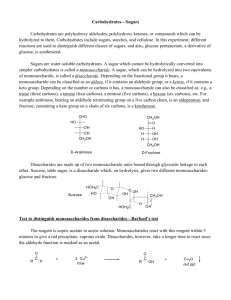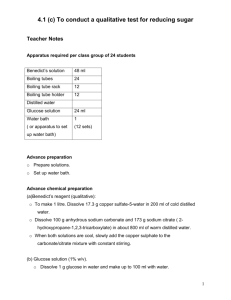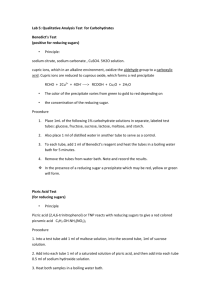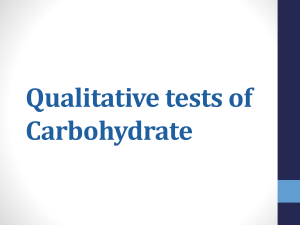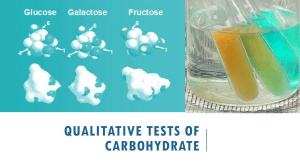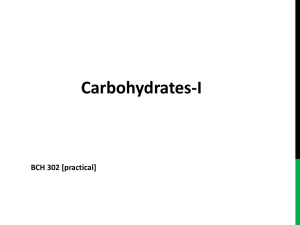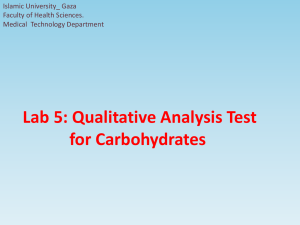There are three types of carbohydrates
advertisement
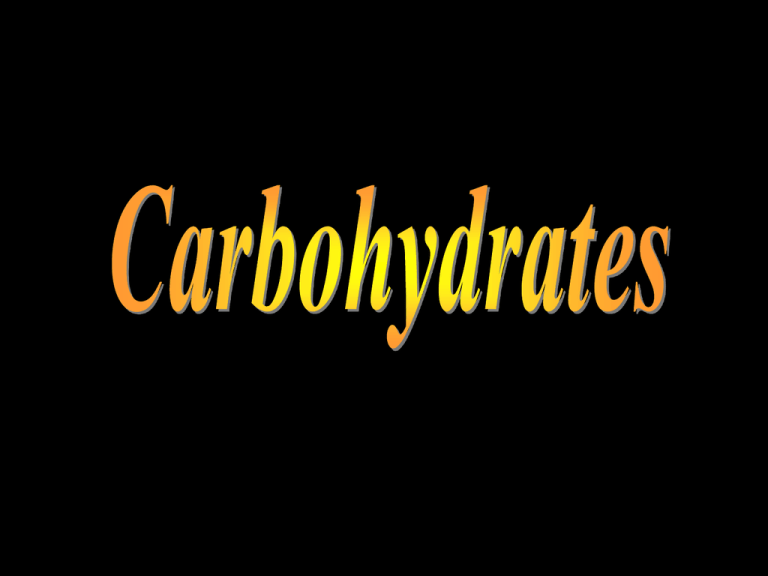
Introduction
•
Carbohydrates are sugars and starches, which
provide energy for humans and animals, and
cellulose which make up many plant structures.
There are three types of carbohydrates:
•
1. Simple, or monosaccharides:
•
•
•
Found in fruits and milk products are more easily digested
by the body.
Also often found in processed refined foods such as white
sugar and white bread.
A monosaccharide is a triose, tetrose, pentose or hexose,
cannot be hydrolyzed to simpler carbohydrates
•
•
•
Glucose: "blood sugar"
Galactose: a sugar in milk
Fructose: a sugar found in honey.
2. Disaccharides :
• monosaccharides covalently linked can be
hydrolyzed into two monosaccharide units.
• Sucrose: common table sugar = glucose +
fructose
•
•
Lactose: major sugar in milk = glucose + galactose
Maltose: product of starch digestion = glucose +
glucose .
Note: Oligosaccharides: a few monosaccharides
covalently linked
3
3. Complex, or polysaccharides: which take longer for
the body to digest, are most commonly found in
vegetables (cellulose), whole grain, breads, rice and
legumes.
A. Starches are polymers of glucose: Two types
are found:
• amylose consists of linear, unbranched chains
of several hundred glucose residues (units).
The glucose residues are linked by a
glycosidic bond between their #1 and #4
carbon atoms.
4
•
amylopectin differs from amylose in being highly
branched. a short side chain is attached by a
glycosidic bond to the #6 carbon atom (the carbon
above the ring). The total number of glucose residues
in a molecule of amylopectin is several thousand.
B. Glycogen
• Animals store excess glucose by polymerizing it to
form glycogen. The structure of glycogen is similar to
the amylopectin, although the branches in glycogen
tend to be shorter and more frequent.
• Glycogen is broken back down into glucose when
energy is needed (a process called glycogenolysis).
C. 5 Cellulose
Structure of Monosaccharides
Aldoses
7
ketoses
8
D vs L Designation
O
H
C
H – C – OH
HO – C – H
H – C – OH
H – C – OH
CH2OH
D-glucose
9
O
H
C
HO – C – H
H – C – OH
HO – C – H
HO – C – H
CH2OH
L-glucose
Reducing and Non-reducing sugars
• Sugars exist in solution as an equilibrium mixture of
open-chain and closed-ring (or cyclic) structures.
• Sugars that can be oxidized by mild oxidizing agents
are called reducing sugars because the oxidizing agent
is reduced in the reaction.
• A non-reducing sugar is not oxidized by mild
oxidizing agents.
• All common monosaccharides are reducing sugars.
• The disaccharides maltose and lactose are reducing
sugars.
• The disaccharide sucrose is a non-reducing sugar.
• Common oxidizing agents used to test for the
presence of a reducing sugar are: Benedict's solution,
Fehling's solution.
10
Ex(1). Benedict's Test
• Benedict's test determines whether a monosaccharide
or disaccharide is a reducing sugar.
• To give a positive test, the carbohydrate must contain
a hemiacetal which will hydrolyse in aqueous solution
to the aldehyde form.
• Benedict's reagent is an alkaline solution containing
cupric ions, which oxidize the aldehyde to a
carboxylic acid.
• In turn, the cupric ions are reduced to cuprous oxide,
which forms a red precipitate. This solution has been
used in clinical laboratories for testing urine.
RCHO + 2Cu2+ + 4OH- -----> RCOOH + Cu2O + 2H2O
11
Hemiacetal & hemiketal formation
H
C
H
O
+
R'
OH
R'
O
R
alcohol
hemiacetal
R
R
O
+
"R
OH
R'
12
OH
R
aldehyde
C
C
ketone
"R
O
C
R'
alcohol
hemiketal
OH
Procedure
1.
2.
3.
4.
Place 1 ml of carbohydrates solutions in test tube.
To each tube, add 1 ml of Benedict's reagent.
Heat the tubes in a boiling water bath for 3-5 minutes.
Remove the tubes from water bath and record the
results.
Result: In the presence of a reducing sugar a precipitate
which may be red , yellow or green will form.
14
Ex(2). Barfoed's Test
• Barfoed's test is similar to Benedict's test, but
determines if a carbohydrate is a monosaccharide or
a disaccharide.
• Barfoed's reagent reacts with monosaccharides to
produce cuprous oxide at a faster rate than
disaccharides do:
RCHO + 2Cu2+ + 2H2O -----> RCOOH + Cu2O + 4H+
Procedure
1.
2.
3.
4.
Place 1ml of the following 1% carbohydrate solutions in
test tubes: glucose, fructose, sucrose, lactose, and
maltose.
To each tube, add 1 ml of Barfoed's reagent.
Heat in a boiling water bath for 10 minutes.
Note and record your observations.
Result: A red precipitate will form if the test is positive.
Ex(3). Bial's (Orcinol) Test for Pentoses
• This test is used to distinguish pentoses from hexoses.
• Bial's reagent contains {orcinol (5-methylresorcinol) in
concentrated HCl with a small amount of FeCl3 catalyst}.
• The test reagent dehydrates pentoses to form furfural.
• Furfural further reacts with orcinol and the iron ion present
in the test reagent to produce a bluish product.
• Not: Be extremely careful when heating the test tubes.
Bial's reagent contains concentrated hydrochloric acid. Do
not point the tube toward yourself or any of your fellow lab
workers.
Procedure
1. Add about 2 ml of 1% carbohydrates solutions.
2. Add 3 ml of Bial's reagent to each tube and mix
well.
3. Carefully heat each tube (with some agitation)
directly over the burner flame.
4. Hold the tube at a diagonal and heat along the
sides of the tube rather than at the bottom to
prevent eruption of the liquid from the tube.
5. Move the tube diagonally in and out of the
flame, until the mixture just begins to boil.
6. Stop heating when the mixture begins to boil.
Result
• A bluish color indicates a positive result.
•
Prolonged heating of some hexoses yields hydroxymethyl
furfural which also reacts with orcinol to give colored
complexes.
Two negative tests (left, middle) and a positive test (right)
Ex(4). Seliwanoff's (Resorcinol) Test For
Ketoses
• This test can differentiate between ketoses and aldoses.
• Seliwanoff's reagent (resorcinol dissolved in 6 M HCl),
• The test reagent dehydrates ketohexoses to form 5hydroxymethylfurfural.
• 5-hydroxymethylfurfural further reacts with resorcinol
present in the test reagent to produce a red product within
two minutes.
• Aldohexoses react to form the same product, but do so more
slowly.
• Ketohexoses (such as fructose) and disaccharides containing
a ketohexose (such as sucrose) form a cherry-red
condensation product.
• Other sugars may produce yellow to faint pink colors.
Procedure
1.
2.
3.
4.
5.
Add about 3 ml of Seliwanoff's reagent to each labeled test
tube.
Add 1 drop of the respective sugar solution to the
appropriate test tubes and mix well.
Place all the test tubes in the boiling water bath at the same
time and heat for 3 min after the water begins to boil again.
Record your observations.
A positive result is indicated by the formation of A red
color with or without the separation of a brown-red
precipitate.
a negative test (left) and a positive test (right)
